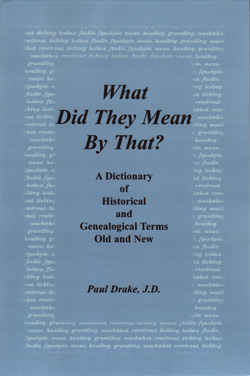 What Did They Mean By That? Is now available at the reduced price of only $19.60, down from $36.
What Did They Mean By That? Is now available at the reduced price of only $19.60, down from $36.
What Did They Mean By That? A Dictionary of Historical and Genealogical Terms Old and New has long been the most popular historical dictionary carried by Family Roots Publishing. This book provides an understanding, in modern terms, for words used in the past. Many of these words, used historically in everyday conversation, to describe items, jobs, events, and technology of the day, are no longer in use or get used with a different meaning. This book provides the background family historians need to grasp the meaning of letters, documents, and sources from the past.
Genealogists enjoy the thoroughness of this book. At 6″ x 9″ and 350 pages this is a big dictionary, and it lists entries paragraph style, instead of using a typical dictionary two-column format. In fact, the book feels a bit more like an encyclopedia than it does a standard dictionary. Most entries provide more than just a standard definition. Rather, entries provide an explanations, examples, and observations. This dictionary has other unique features as well. What Did They Mean By That includes images. While not on every page, the pictures do provide both an element of interest as well as prove educational. Some of the images are pictures and some are document samples. There is also a small chart at the beginning showing a comparison between Saxon and English alphabets.
With that all said, perhaps the best review of this book is the one the book gives itself on the back cover:
“The family historian must seek out the records of the merchants, courts, legislators, and churches, as well as the everyday expressions of the common men and women, all the while striving to remain aware that just as we have created words like television, computer, microwave oven, automobile, space station, gigabyte, and airplane, and set aside words as ticking and icebox, stadle, and squabpie, our ancestors had to do the same. They made up the likes of telegraph, railroad, and telescope, and assimilated German words like hex, sauerkraut, fresh, hoodlum, and kindergarten; Spanish words such as barbeque, chocolate, and tornado; French sounds like bayou, levee, depot, and chowder; and Indian words such as hickory, pecan, hominy, moccasin, and raccoon. Though they invented the likes of popcorn, sweet potato, eggplant, bullfrog, and backwoodsman, they left behind them terms no longer needed in their daily lives. Gone were the likes of moxa (Indian moss burned on an area of the body, thought to cure gout), hautboy (oboe), gruntling (young hog), muchwhat (nearly), revelrout (a ruckus), and, from most regions of the U.S., the long “a” sounds of old England (fahst for fast, dahnce for dance, and hoff, meaning half).
In addition to terminology, such as the names of the many courts and legal processes, this collection of more than 4500 words includes many occupations, descriptions of early furniture and foods, common medical terms and herbal remedies, and many all but forgotten expressions. The words found here are seen at every turn of research; in court documents (especially inventories of estates, court entries, and lawsuits), church records, books, newspapers, letters, and songs.”
What Did They Mean By That? A Dictionary of Historical and Genealogical Terms, Old and New is available from Family Roots Publishing.